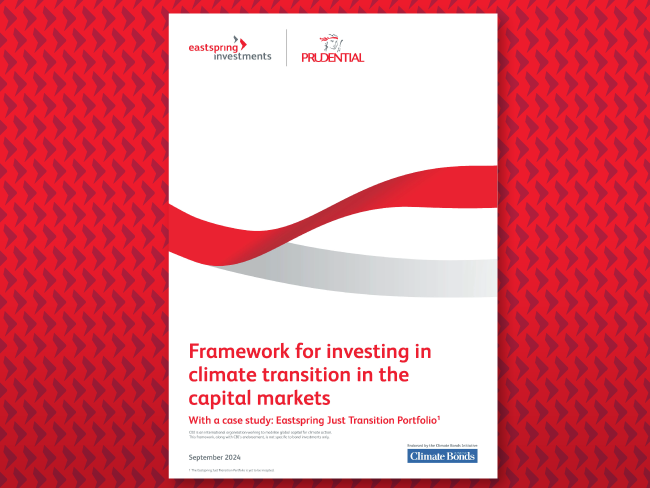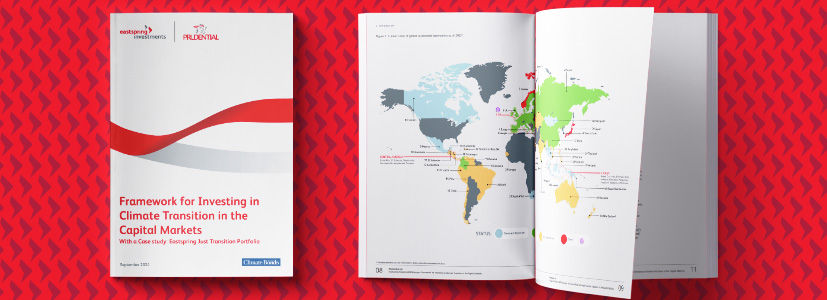Eastspring Investments has co-authored a whitepaper with our parent Prudential plc that aims to provide a comprehensive asset allocation and investment approach for both Asset Owners and Asset Managers respectively.
At the Asset Owner level, the whitepaper outlines our parent’s approach to Financing the Transition. This approach highlights the importance of considering hard-to-abate sectors and emerging markets, in line with the Paris Agreement’s principle of 'common but differentiated responsibilities.' At the Asset Manager level, the paper proposes a framework for building a climate transition portfolio.
The need for a different approach to climate investing
The mobilisation of capital to bridge the transition financing gap is crucial for meeting the goals of the Paris Agreement. Nevertheless, the potential of capital markets has not been fully realised, partly because existing transition solutions do not effectively measure progress at the company level.
For example, current solutions, such as Sustainable Finance Taxonomies, define green and transition-eligible activities but are primarily useful for project financing. Guidelines from industry bodies like the Climate Bond Initiative (CBI) and the Glasgow Financial Alliance for Net Zero (GFANZ) provide direction but lack detailed, scalable data for measuring company progress.
Most current data solutions focus on companies with reduced emissions or those already providing green solutions. These types of funds constitute approximately 61% of global climate fund assets. The remaining 39% focus on a broad range of companies considering climate change, yet 73% of these are passive funds that mainly aim to reduce emissions1.
We must go beyond focusing solely on emissions reduction or companies focusing purely on providing primarily green solutions. The challenge is to identify companies that are either already aligned with, or making credible progress toward, both national and international sustainable finance guidelines. This includes:
- Ensuring market inclusivity of eligible companies across different sectors, including high-emission ones.
- Considering the social aspect of a just transition, meaning climate progress should not compromise human rights.
A framework for building a climate transition portfolio
The framework presents a practical approach to building a climate transition portfolio of companies taking concrete actions in tapping on transition opportunities and are managing emissions in alignment with industry best-practice transition principles (e.g. Climate Bonds’ Initiative) and the transition component of Sustainable Finance Taxonomies. By incorporating engagement and reporting throughout the investment lifecycle, the concept of a just transition can be implemented at a capital markets scale by both asset managers and asset owners.
Key components of the framework include:
- Composite Transition Portfolio Screen : A screen combining data from independent providers to measure transition opportunities and emissions reduction efforts.
- Engagement and Monitoring : Ongoing engagement to ensure companies are meeting transition goals and considering social factors.
- Reporting : Transparency and accountability through regular reporting on progress.
Case study: Eastspring Investments’ Just Transition Portfolio
The whitepaper features a case study on Eastspring Investments' Just Transition Portfolio, which focuses on the Asia Pacific region. This portfolio targets high-emission sectors and applies the proposed screening framework, including social engagement. Applying this framework results in approximately 1,000 companies, ensuring sufficient sector and market coverage for a cross-strategies capital markets portfolio. The portfolio also generally has a lower emissions profile and higher social and governance scores compared to a broader market index when tested on third party ESG data (as at May 2024).
Singapore by Eastspring Investments (Singapore) Limited (UEN: 199407631H)
Australia (for wholesale clients only) by Eastspring Investments (Singapore) Limited (UEN: 199407631H), which is incorporated in Singapore, is exempt from the requirement to hold an Australian financial services licence and is licensed and regulated by the Monetary Authority of Singapore under Singapore laws which differ from Australian laws
Hong Kong by Eastspring Investments (Hong Kong) Limited and has not been reviewed by the Securities and Futures Commission of Hong Kong.
Indonesia by PT Eastspring Investments Indonesia, an investment manager that is licensed, registered and supervised by the Indonesia Financial Services Authority (OJK).
Malaysia by Eastspring Investments Berhad (200001028634/ 531241-U) and Eastspring Al-Wara’ Investments Berhad (200901017585 / 860682-K).
Thailand by Eastspring Asset Management (Thailand) Co., Ltd.
United States of America (for institutional clients only) by Eastspring Investments (Singapore) Limited (UEN: 199407631H), which is incorporated in Singapore and is registered with the U.S Securities and Exchange Commission as a registered investment adviser.
European Economic Area (for professional clients only) and Switzerland (for qualified investors only) by Eastspring Investments (Luxembourg) S.A., 26, Boulevard Royal, 2449 Luxembourg, Grand-Duchy of Luxembourg, registered with the Registre de Commerce et des Sociétés (Luxembourg), Register No B 173737.
United Kingdom (for professional clients only) by Eastspring Investments (Luxembourg) S.A. - UK Branch, 10 Lower Thames Street, London EC3R 6AF.
Chile (for institutional clients only) by Eastspring Investments (Singapore) Limited (UEN: 199407631H), which is incorporated in Singapore and is licensed and regulated by the Monetary Authority of Singapore under Singapore laws which differ from Chilean laws.
The afore-mentioned entities are hereinafter collectively referred to as Eastspring Investments.
The views and opinions contained herein are those of the author, and may not necessarily represent views expressed or reflected in other Eastspring Investments’ communications. This document is solely for information purposes and does not have any regard to the specific investment objective, financial situation and/or particular needs of any specific persons who may receive this document. This document is not intended as an offer, a solicitation of offer or a recommendation, to deal in shares of securities or any financial instruments. It may not be published, circulated, reproduced or distributed without the prior written consent of Eastspring Investments. Reliance upon information in this document is at the sole discretion of the reader. Please carefully study the related information and/or consult your own professional adviser before investing.
Investment involves risks. Past performance of and the predictions, projections, or forecasts on the economy, securities markets or the economic trends of the markets are not necessarily indicative of the future or likely performance of Eastspring Investments or any of the funds managed by Eastspring Investments.
Information herein is believed to be reliable at time of publication. Data from third party sources may have been used in the preparation of this material and Eastspring Investments has not independently verified, validated or audited such data. Where lawfully permitted, Eastspring Investments does not warrant its completeness or accuracy and is not responsible for error of facts or opinion nor shall be liable for damages arising out of any person’s reliance upon this information. Any opinion or estimate contained in this document may subject to change without notice.
Eastspring Investments companies (excluding joint venture companies) are ultimately wholly owned/indirect subsidiaries of Prudential plc of the United Kingdom. Eastspring Investments companies (including joint venture companies) and Prudential plc are not affiliated in any manner with Prudential Financial, Inc., a company whose principal place of business is in the United States of America or with the Prudential Assurance Company Limited, a subsidiary of M&G plc (a company incorporated in the United Kingdom).







